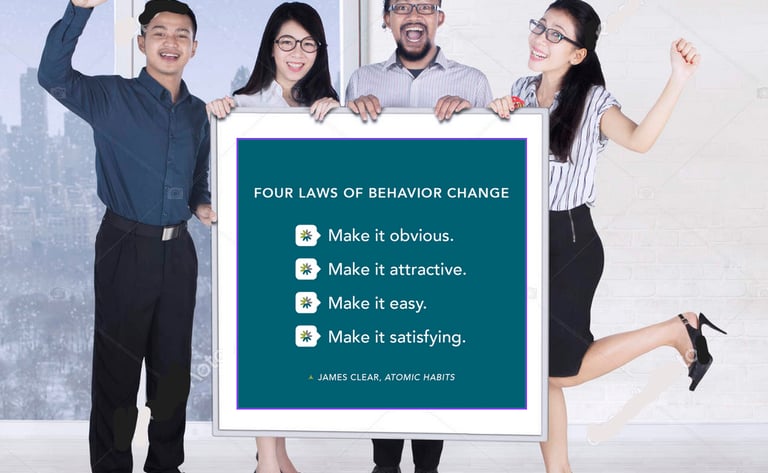Cultivating Organizational Change Using James Clear's Laws of Behavior Change
2/15/20233 min read
In the dynamic landscape of today's business world, organizational change is not just a “nice to have” but a necessity for growth and adaptability. However, leading and navigating through change can be a complex endeavor. James Clear, in his book "Atomic Habits," presents the 4 Laws of Behavior Change, which offer valuable insights into how individuals can create positive habits. In this blog, I’ll share how these laws can be applied to support organizational change management activities, helping leaders and employees navigate change within the workplace. If you haven't read "Atomic Habits" yet, definitely check it out!
1. Make It Obvious: Defining the Change Vision – This is your WHY
The first law emphasizes the importance of clarity in creating habits. Similarly, in organizational change, leaders must make the change vision obvious. This involves clearly articulating the reasons behind the change, the expected outcomes, and the impact on employees and the organization as a whole. Without a clear vision, employees may struggle to understand the purpose of the change, leading to resistance and confusion.
Communication is Key: Ensure that communication channels are open and transparent. Leaders should consistently communicate the vision, goals, and benefits of the change. Utilize multiple channels such as town hall meetings, emails, and intranet updates to reinforce the message.
Provide Context: Help employees understand the broader context of the change. Explain how it aligns with the company's mission, values, and long-term strategy. When individuals understand the "why" behind the change, they are more likely to embrace it.
2. Make It Attractive: Building a Positive Change Culture
The second law focuses on making habits attractive. In organizational change, it's crucial to create an environment where change is seen as not only necessary but also desirable. This involves fostering a positive change culture that values innovation, growth, and continuous improvement.
Leadership Modeling: Leaders must embody the change they seek. When employees see leaders actively participating in and supporting the change, it becomes more attractive. This could involve showcasing success stories, acknowledging and rewarding those who embrace the change, and visibly championing the new direction.
Highlight Benefits: Clearly communicate the benefits of the change to both the organization and individuals. Help employees see how the change aligns with personal and professional development opportunities. When people perceive there are positive outcomes for them, they are more likely to be motivated to participate.
3. Make It Easy: Ensure the Change Process is Easy
The third law emphasizes the importance of simplicity in habit formation. Similarly, in organizational change, leaders must strive to make the change process as easy and streamlined as possible. This involves removing barriers, providing resources, and simplifying the steps required for individuals to adapt to the change.
Training and Support: Invest in comprehensive and appropriate training programs to equip employees with the skills and knowledge needed for the change. Offer ongoing support through mentorship, coaching, or access to resources that facilitate the learning process. The easier it is for employees to acquire the necessary skills, the more likely they are to embrace the change.
Feedback Loops: Establish feedback mechanisms that allow employees to share their experiences, ask questions, and provide suggestions. This creates a continuous improvement loop where leaders can identify and address challenges, making the change process smoother over time.
4. Make It Satisfying: Celebrating Milestones and Successes
The fourth law focuses on the importance of immediate rewards to reinforce habits. In organizational change, leaders should celebrate milestones and successes to provide immediate satisfaction and reinforcement for employees who are adapting to the new ways of working.
Recognition and Rewards: Acknowledge and celebrate individual and team achievements related to the change. This could involve public recognition, rewards, or even a simple thank-you message. Celebrating small victories creates a positive atmosphere and reinforces the idea that the change is bringing about positive results.
Adapt and Recognize: Be adaptable in the face of challenges and learn from both successes and failures. Acknowledge that the change process is dynamic, and adjustments may be necessary. Recognizing the efforts of employees, even when faced with setbacks, contributes to a culture of resilience and continuous improvement.
By aligning James Clear's 4 Laws of Behavior Change with organizational change management best practices, leaders can create a more effective and sustainable approach to navigating change within the workplace. Making the change vision obvious, attractive, easy, and satisfying ensures that employees not only understand the need for change but are also motivated to actively participate in the process. Ultimately, successful organizational change is not just about implementing new processes; it's about fostering a culture that embraces and thrives on continuous improvement and adaptation.


Let's connect!
917.231.0337
info@IgniteGlobalConsulting.com


Ignite Global Consulting
